Jianing Li
Long-Distance Field Demonstration of Imaging-Free Drone Identification in Intracity Environments
Apr 26, 2025Abstract:Detecting small objects, such as drones, over long distances presents a significant challenge with broad implications for security, surveillance, environmental monitoring, and autonomous systems. Traditional imaging-based methods rely on high-resolution image acquisition, but are often constrained by range, power consumption, and cost. In contrast, data-driven single-photon-single-pixel light detection and ranging (\text{D\textsuperscript{2}SP\textsuperscript{2}-LiDAR}) provides an imaging-free alternative, directly enabling target identification while reducing system complexity and cost. However, its detection range has been limited to a few hundred meters. Here, we introduce a novel integration of residual neural networks (ResNet) with \text{D\textsuperscript{2}SP\textsuperscript{2}-LiDAR}, incorporating a refined observation model to extend the detection range to 5~\si{\kilo\meter} in an intracity environment while enabling high-accuracy identification of drone poses and types. Experimental results demonstrate that our approach not only outperforms conventional imaging-based recognition systems, but also achieves 94.93\% pose identification accuracy and 97.99\% type classification accuracy, even under weak signal conditions with long distances and low signal-to-noise ratios (SNRs). These findings highlight the potential of imaging-free methods for robust long-range detection of small targets in real-world scenarios.
EmbodiedOcc++: Boosting Embodied 3D Occupancy Prediction with Plane Regularization and Uncertainty Sampler
Apr 13, 2025Abstract:Online 3D occupancy prediction provides a comprehensive spatial understanding of embodied environments. While the innovative EmbodiedOcc framework utilizes 3D semantic Gaussians for progressive indoor occupancy prediction, it overlooks the geometric characteristics of indoor environments, which are primarily characterized by planar structures. This paper introduces EmbodiedOcc++, enhancing the original framework with two key innovations: a Geometry-guided Refinement Module (GRM) that constrains Gaussian updates through plane regularization, along with a Semantic-aware Uncertainty Sampler (SUS) that enables more effective updates in overlapping regions between consecutive frames. GRM regularizes the position update to align with surface normals. It determines the adaptive regularization weight using curvature-based and depth-based constraints, allowing semantic Gaussians to align accurately with planar surfaces while adapting in complex regions. To effectively improve geometric consistency from different views, SUS adaptively selects proper Gaussians to update. Comprehensive experiments on the EmbodiedOcc-ScanNet benchmark demonstrate that EmbodiedOcc++ achieves state-of-the-art performance across different settings. Our method demonstrates improved edge accuracy and retains more geometric details while ensuring computational efficiency, which is essential for online embodied perception. The code will be released at: https://github.com/PKUHaoWang/EmbodiedOcc2.
SliceOcc: Indoor 3D Semantic Occupancy Prediction with Vertical Slice Representation
Jan 28, 2025



Abstract:3D semantic occupancy prediction is a crucial task in visual perception, as it requires the simultaneous comprehension of both scene geometry and semantics. It plays a crucial role in understanding 3D scenes and has great potential for various applications, such as robotic vision perception and autonomous driving. Many existing works utilize planar-based representations such as Bird's Eye View (BEV) and Tri-Perspective View (TPV). These representations aim to simplify the complexity of 3D scenes while preserving essential object information, thereby facilitating efficient scene representation. However, in dense indoor environments with prevalent occlusions, directly applying these planar-based methods often leads to difficulties in capturing global semantic occupancy, ultimately degrading model performance. In this paper, we present a new vertical slice representation that divides the scene along the vertical axis and projects spatial point features onto the nearest pair of parallel planes. To utilize these slice features, we propose SliceOcc, an RGB camera-based model specifically tailored for indoor 3D semantic occupancy prediction. SliceOcc utilizes pairs of slice queries and cross-attention mechanisms to extract planar features from input images. These local planar features are then fused to form a global scene representation, which is employed for indoor occupancy prediction. Experimental results on the EmbodiedScan dataset demonstrate that SliceOcc achieves a mIoU of 15.45% across 81 indoor categories, setting a new state-of-the-art performance among RGB camera-based models for indoor 3D semantic occupancy prediction. Code is available at https://github.com/NorthSummer/SliceOcc.
EventGPT: Event Stream Understanding with Multimodal Large Language Models
Dec 01, 2024



Abstract:Event cameras record visual information as asynchronous pixel change streams, excelling at scene perception under unsatisfactory lighting or high-dynamic conditions. Existing multimodal large language models (MLLMs) concentrate on natural RGB images, failing in scenarios where event data fits better. In this paper, we introduce EventGPT, the first MLLM for event stream understanding, to the best of our knowledge, marking a pioneering attempt to integrate large language models (LLMs) with event stream comprehension. To mitigate the huge domain gaps, we develop a three-stage optimization paradigm to gradually equip a pre-trained LLM with the capability of understanding event-based scenes. Our EventGPT comprises an event encoder, followed by a spatio-temporal aggregator, a linear projector, an event-language adapter, and an LLM. Firstly, RGB image-text pairs generated by GPT are leveraged to warm up the linear projector, referring to LLaVA, as the gap between natural image and language modalities is relatively smaller. Secondly, we construct a synthetic yet large dataset, N-ImageNet-Chat, consisting of event frames and corresponding texts to enable the use of the spatio-temporal aggregator and to train the event-language adapter, thereby aligning event features more closely with the language space. Finally, we gather an instruction dataset, Event-Chat, which contains extensive real-world data to fine-tune the entire model, further enhancing its generalization ability. We construct a comprehensive benchmark, and experiments show that EventGPT surpasses previous state-of-the-art MLLMs in generation quality, descriptive accuracy, and reasoning capability.
HDI-Former: Hybrid Dynamic Interaction ANN-SNN Transformer for Object Detection Using Frames and Events
Nov 27, 2024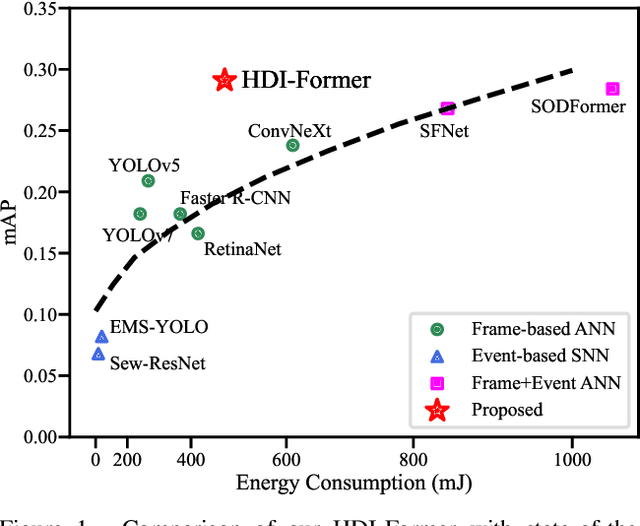
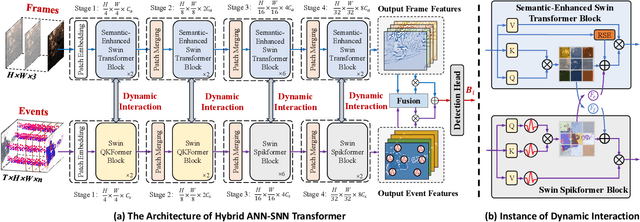

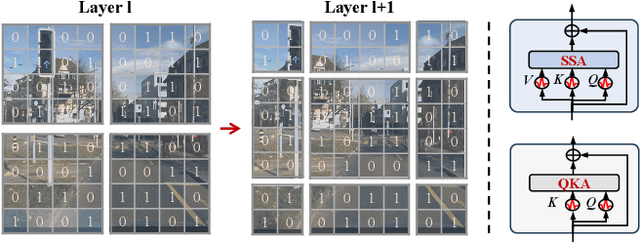
Abstract:Combining the complementary benefits of frames and events has been widely used for object detection in challenging scenarios. However, most object detection methods use two independent Artificial Neural Network (ANN) branches, limiting cross-modality information interaction across the two visual streams and encountering challenges in extracting temporal cues from event streams with low power consumption. To address these challenges, we propose HDI-Former, a Hybrid Dynamic Interaction ANN-SNN Transformer, marking the first trial to design a directly trained hybrid ANN-SNN architecture for high-accuracy and energy-efficient object detection using frames and events. Technically, we first present a novel semantic-enhanced self-attention mechanism that strengthens the correlation between image encoding tokens within the ANN Transformer branch for better performance. Then, we design a Spiking Swin Transformer branch to model temporal cues from event streams with low power consumption. Finally, we propose a bio-inspired dynamic interaction mechanism between ANN and SNN sub-networks for cross-modality information interaction. The results demonstrate that our HDI-Former outperforms eleven state-of-the-art methods and our four baselines by a large margin. Our SNN branch also shows comparable performance to the ANN with the same architecture while consuming 10.57$\times$ less energy on the DSEC-Detection dataset. Our open-source code is available in the supplementary material.
Event Stream based Sign Language Translation: A High-Definition Benchmark Dataset and A New Algorithm
Aug 20, 2024



Abstract:Sign Language Translation (SLT) is a core task in the field of AI-assisted disability. Unlike traditional SLT based on visible light videos, which is easily affected by factors such as lighting, rapid hand movements, and privacy breaches, this paper proposes the use of high-definition Event streams for SLT, effectively mitigating the aforementioned issues. This is primarily because Event streams have a high dynamic range and dense temporal signals, which can withstand low illumination and motion blur well. Additionally, due to their sparsity in space, they effectively protect the privacy of the target person. More specifically, we propose a new high-resolution Event stream sign language dataset, termed Event-CSL, which effectively fills the data gap in this area of research. It contains 14,827 videos, 14,821 glosses, and 2,544 Chinese words in the text vocabulary. These samples are collected in a variety of indoor and outdoor scenes, encompassing multiple angles, light intensities, and camera movements. We have benchmarked existing mainstream SLT works to enable fair comparison for future efforts. Based on this dataset and several other large-scale datasets, we propose a novel baseline method that fully leverages the Mamba model's ability to integrate temporal information of CNN features, resulting in improved sign language translation outcomes. Both the benchmark dataset and source code will be released on https://github.com/Event-AHU/OpenESL
Classifier Guidance Enhances Diffusion-based Adversarial Purification by Preserving Predictive Information
Aug 12, 2024Abstract:Adversarial purification is one of the promising approaches to defend neural networks against adversarial attacks. Recently, methods utilizing diffusion probabilistic models have achieved great success for adversarial purification in image classification tasks. However, such methods fall into the dilemma of balancing the needs for noise removal and information preservation. This paper points out that existing adversarial purification methods based on diffusion models gradually lose sample information during the core denoising process, causing occasional label shift in subsequent classification tasks. As a remedy, we suggest to suppress such information loss by introducing guidance from the classifier confidence. Specifically, we propose Classifier-cOnfidence gUided Purification (COUP) algorithm, which purifies adversarial examples while keeping away from the classifier decision boundary. Experimental results show that COUP can achieve better adversarial robustness under strong attack methods.
3D-UGCN: A Unified Graph Convolutional Network for Robust 3D Human Pose Estimation from Monocular RGB Images
Jul 23, 2024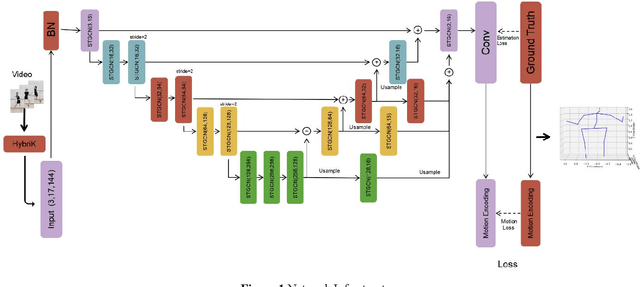
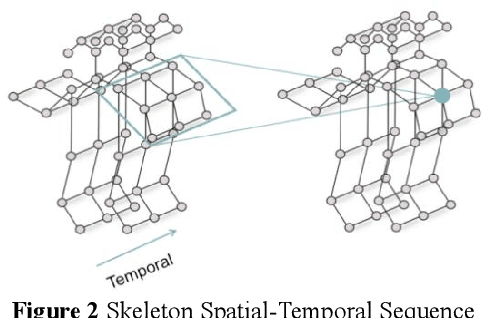
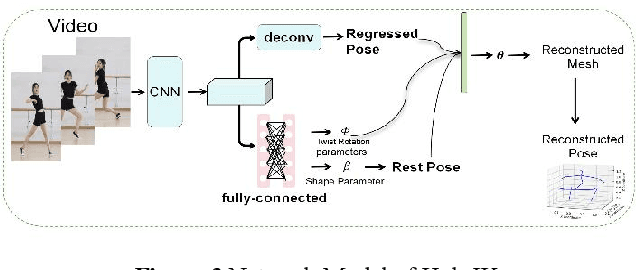
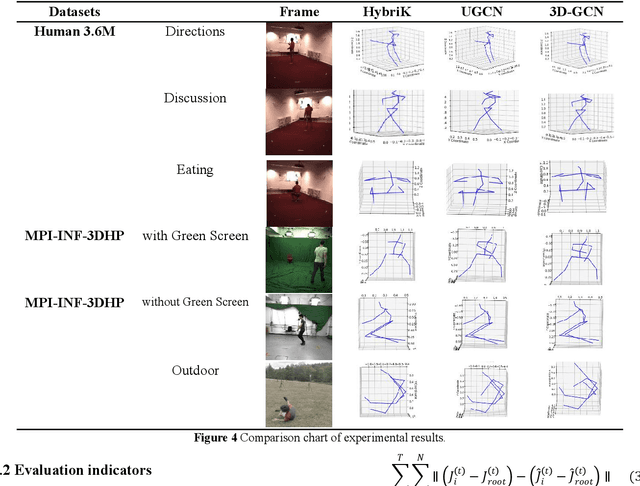
Abstract:Human pose estimation remains a multifaceted challenge in computer vision, pivotal across diverse domains such as behavior recognition, human-computer interaction, and pedestrian tracking. This paper proposes an improved method based on the spatial-temporal graph convolution net-work (UGCN) to address the issue of missing human posture skeleton sequences in single-view videos. We present the improved UGCN, which allows the network to process 3D human pose data and improves the 3D human pose skeleton sequence, thereby resolving the occlusion issue.
Dissecting Multiplication in Transformers: Insights into LLMs
Jul 22, 2024Abstract:Transformer-based large language models have achieved remarkable performance across various natural language processing tasks. However, they often struggle with seemingly easy tasks like arithmetic despite their vast capabilities. This stark disparity raise human's concerns about their safe and ethical use, hinder their widespread adoption.In this paper, we focus on a typical arithmetic task, integer multiplication, to explore and explain the imperfection of transformers in this domain. We provide comprehensive analysis of a vanilla transformer trained to perform n-digit integer multiplication. Our observations indicate that the model decomposes multiplication task into multiple parallel subtasks, sequentially optimizing each subtask for each digit to complete the final multiplication. Based on observation and analysis, we infer the reasons of transformers deficiencies in multiplication tasks lies in their difficulty in calculating successive carryovers and caching intermediate results, and confirmed this inference through experiments. Guided by these findings, we propose improvements to enhance transformers performance on multiplication tasks. These enhancements are validated through rigorous testing and mathematical modeling, not only enhance transformer's interpretability, but also improve its performance, e.g., we achieve over 99.9% accuracy on 5-digit integer multiplication with a tiny transformer, outperform LLMs GPT-4. Our method contributes to the broader fields of model understanding and interpretability, paving the way for analyzing more complex tasks and Transformer models. This work underscores the importance of explainable AI, helping to build trust in large language models and promoting their adoption in critical applications.
Technique Report of CVPR 2024 PBDL Challenges
Jun 15, 2024
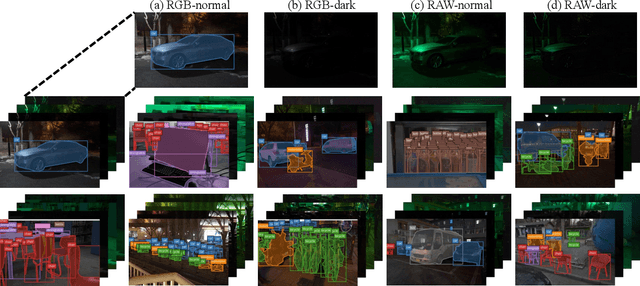
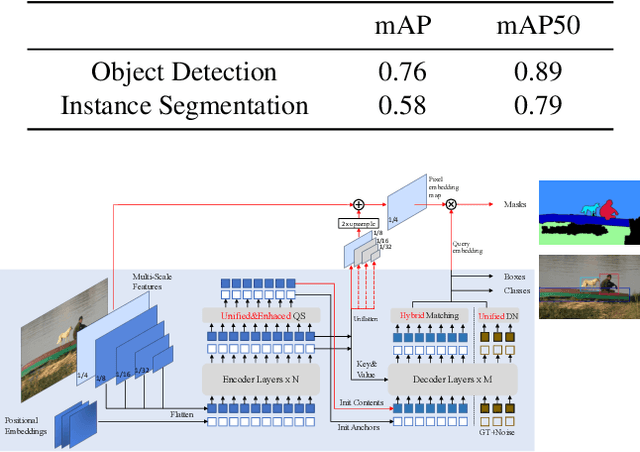

Abstract:The intersection of physics-based vision and deep learning presents an exciting frontier for advancing computer vision technologies. By leveraging the principles of physics to inform and enhance deep learning models, we can develop more robust and accurate vision systems. Physics-based vision aims to invert the processes to recover scene properties such as shape, reflectance, light distribution, and medium properties from images. In recent years, deep learning has shown promising improvements for various vision tasks, and when combined with physics-based vision, these approaches can enhance the robustness and accuracy of vision systems. This technical report summarizes the outcomes of the Physics-Based Vision Meets Deep Learning (PBDL) 2024 challenge, held in CVPR 2024 workshop. The challenge consisted of eight tracks, focusing on Low-Light Enhancement and Detection as well as High Dynamic Range (HDR) Imaging. This report details the objectives, methodologies, and results of each track, highlighting the top-performing solutions and their innovative approaches.
 Add to Chrome
Add to Chrome Add to Firefox
Add to Firefox Add to Edge
Add to Edge